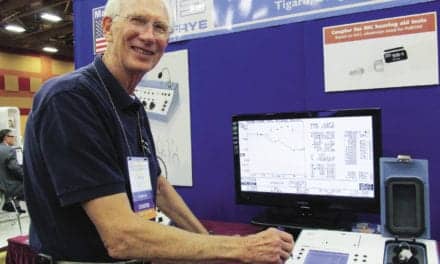Patient newsletters have gotten considerable attention lately. A number of recent articles1-4 suggest that regular contact with hearing aid users can provide for more successful hearing aid use, greater hearing aid satisfaction, and increased patient loyalty.
In addition, direct marketing—which is only one aspect of the patient newsletter—is by far the most cost-effective marketing a practice can do. Almost every person on the mailing list of a hearing care practice has hearing loss, knows the provider, and either uses or is considering the use of hearing aids. What other marketing approach can focus on such a highly-defined market segment?
Is marketing to patients consistent with the recent HIPAA (Health Insurance Portability and Accountability Act) regulations? Yes. According to the HIPAA website5:
“At the same time, the (HIPAA) proposal would permit…covered entities to communicate freely with patients about treatment options and other health-related information.”

Figure 1. Rachel Kruppa, MA, and Kim Nolde, MS, of East Valley Otolaryngologists in Mesa, Ariz, used their newsletter to announce a new hearing aid service plan and to let their patients know Kim was back to work after the birth of her first child.
And according to the Office of Civil Rights Guidelines released in December 2002, as summarized in the March/April issue of Audiology Today,6 hearing care professionals are permitted to:
- Contact their patients with promotional offers, incentives and coupons;
- Contact their patients to communicate about products and services, but must allow their patient to “opt out” of these types of communications. (Note: Many subscribers use their newsletter to inform their patients about HIPAA requirements and to offer them the opportunity to “opt out” of office mailings.)
At Hearing HealthCare News®, we have been helping audiologists and hearing aid dispensers communicate with their patients since 1986, with more than 20 million patient newsletters distributed to hearing aid users and their families. Regular communication provided by these newsletters has been valuable to both the patients and the practices that serve them, and 90% of the professional subscribers renew their subscriptions year after year.
Although we do the writing, lay-out, and printing of the newsletter, each subscriber is able to customize their newsletter several ways before the finished copies are printed and shipped. Subscribers use photos, logos, coupons, and information they’ve gleaned from their own practice or from the field to personalize their newsletters. Here are some of the ways our subscribers have customized their newsletters:
Personal information. Patients love hearing about the birth of a child, a graduation, or anything that supports the personal relationship we develop with our patients. This type of information is particularly effective in a tight-knit community and serves both to inform and intimate that our business/practice is an integral part of that community. For example, William Helmholtz III, AuD, of First Choice Audiology in Colorado Springs, Col, received many congratulations from his patients after printing a photo of his new son, Josef.
Professional information. Vangie Neeley-Marshall of Advanced Hearing Care in Valdosta, Ga, let her patients know when she received her AuD degree. Others write about the continuing education and professional conferences they attend, as they keep current with the latest developments in the field. Updates like these show patients that you are committed to providing the best technology and state-of-the-art care and take your professional credentials seriously.
Office news. Patients are interested in office hours, staff changes, and information about the office and professional staff. When Kristen Bish, MS, joined her practice, Mary Ann Larkin, AuD, of Advanced Hearing Care in Mt. Pleasant, SC, “introduced” her to patients by telling them about Kristen’s educational background and experience. Jeff Worgul, MS, of County Hearing and Balance in Waterford, Conn, announced the relocation of an office. Additionally, many subscribers have used the newsletter as a vehicle to inform their patients about HIPAA privacy regulations. This can help prepare people in advance for the HIPAA-related forms that will need to be filled out at their next visit.
Consumer seminars. The newsletter is an easy way to alert patients about seminars and open houses where new technology and instruments are presented. Rick Hetsko, MEd, of Oberlin Hearing Care in Oberlin, Ohio, encouraged his patients to share the news about an upcoming Hearing Awareness and Open House with “friends, family members, or loved ones who have hearing problems,” and dispensed 22 hearing aids as a result.
Many subscribers use the newsletter to encourage referrals from their current patients.The West Texas Rehabilitation Center in Abilene, Tex, let their patients know about their other clinical services, including diagnostic and vestibular rehabilitation services for dizziness.
Patient Survey Results. Do you survey your patients? Do you get good results? Patients and local physicians should know about those excellent patient satisfaction ratings. In my office, we received many comments when we wrote that although “96% are satisfied or very satisfied with their audiologist, Kathleen likes to point out that her ratings are higher than mine!” Scott Frink of Salem Audiology Clinic in Salem, Ore, used the newsletter to conduct a patient satisfaction survey and to encourage patient testimonials. The office received several hundred responses and several patient testimonials were subsequently used in newspaper ads.
New Products. Many subscribers provide information about new hearing aid models, related products such as drying appliances, battery sales, and assistive listening devices. Information about new technology and new hearing aid models allows patients to come to the office “pre-informed” and ready to seek additional information. Michael Marion, MS, of The Hearing Center in Camarillo, Calif, promotes battery sales twice a year. He says that net income from battery sales more than pays for the annual cost of the newsletter. Greg Lowe, PhD, AuD, of Fort Wayne, Ind, described the features of a new hearing aid to his current users (ie, “multiple-channel signal processing system, automatic directional microphone”) and dispensed several aids to current hearing aid users as a result.
Summary
Personalized messages reinforce the relationship between the dispensing professional and the hearing aid user, even as the information helps sell new products and services. A patient newsletter also provides other information that is helpful to people with hearing loss, making the newsletter a valued service. Articles on travel tips for people with hearing loss, suggestions for noisy restaurants, hearing aid care, how to use lipreading, and information for family and friends all help the person with hearing loss cope more successfully with this chronic condition that usually can be helped but not cured.
Thus, a newsletter can be considered both a very effective marketing strategy and a form of ongoing treatment. That’s why a newsletter is good for patients—and great for a dispensing practice.
| This article was submitted to HR by Dennis Hampton, PhD, an audiologist and editor of Hearing HealthCare News®, a customized patient newsletter, and Audiology HealthCare News®, a customized physician newsletter. Correspondence can be addressed to HR or Dennis Hampton, PhD, 280 Mamaroneck Ave, Ste 204, White Plains, NY 10605; email: [email protected]. |
References
1. Kochkin, S. MarkeTrak III identifies key factors in determining consumer satisfaction. Hear Jour. 1992;45 (8):39-44.
2. Hampton, D. Using patient newsletters in an audiology practice. The ASHA Leader. 2003;8 (2):6-7, 34.
3. Pritts, M. Make your newsletter sell for you. Advance for Audiologists. 2003;5(3):44-47.
4. Levinson, J. Guerilla marketing, Boston: Houghton-Mifflin; 1984.
5. Dept of Health and Human Services Office of Civil Rights. Found at: www.hhs.gov/news/press/2002pres/20020321.html. Accessed June 19, 2003.
6. Clarification. Audiol Today 2003;15(2):17.





